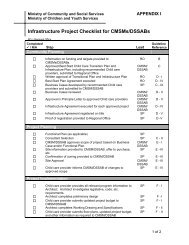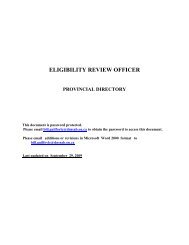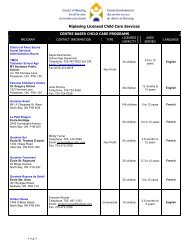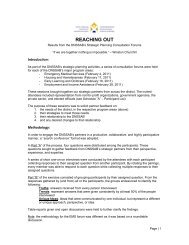Nipissing District Housing Needs, Supply & Affordability ... - dnssab
Nipissing District Housing Needs, Supply & Affordability ... - dnssab
Nipissing District Housing Needs, Supply & Affordability ... - dnssab
You also want an ePaper? Increase the reach of your titles
YUMPU automatically turns print PDFs into web optimized ePapers that Google loves.
KEY FINDINGS<br />
<br />
<br />
<br />
<br />
<br />
<br />
<br />
<br />
Bonfield has also experienced population decline since 2001 (-2.5%), which occurred<br />
within its children and youth age-groups. Although there was no change in the<br />
number of Bonfield’s core wage-earners since 2001, this age group presently<br />
accounts for approximately 60% of Bonfield’s population which is one of the highest,<br />
per-capita rates in <strong>Nipissing</strong> <strong>District</strong>. The population-share of seniors in Bonfield is<br />
11% which is the second lowest in the <strong>District</strong>.<br />
West <strong>Nipissing</strong> has one of the highest rates of ageing in <strong>Nipissing</strong> <strong>District</strong>. Since<br />
1986, the senior citizen population of West <strong>Nipissing</strong> and its former municipalities<br />
has nearly doubled (includes the period of municipal restructuring) and the number of<br />
seniors is now larger than each of the children and youth populations. As the seniors<br />
population is averaging almost twice the growth rate of the wage-earning population,<br />
West <strong>Nipissing</strong>’s dependency ratio of 52 is the second highest in the <strong>District</strong>.<br />
Mattawa’s population decreased by 12% since 2001 which is its largest intercensal<br />
decline in the past 40 years. Although the number of seniors has not been increasing<br />
significantly in Mattawa, the continual loss of population in the other age groups is<br />
resulting in the share of seniors being very high – currently it is 20% which is the<br />
second highest in the <strong>District</strong>. This factor, combined with the declining youth and<br />
wage-earning populations results in a dependency ratio of 57 – the highest in<br />
<strong>Nipissing</strong> <strong>District</strong>.<br />
The East <strong>Nipissing</strong> Planning Area (Calvin, Mattawan and Papineau-Cameron) had<br />
average growth of 5.5% since 2001. Although it has a relatively smaller share of<br />
seniors compared to the <strong>District</strong>, the rate of increase in this age group is one of the<br />
<strong>District</strong>’s highest – the seniors population has nearly doubled since 1986.<br />
Within <strong>Nipissing</strong> <strong>District</strong>, Chisholm has experienced the greatest population growth<br />
since 2001 – it has the lowest per-capita share of seniors in <strong>Nipissing</strong> and one of the<br />
highest shares of youth. Chisholm’s senior citizen population remains smaller than<br />
each of its children and youth populations and it has the lowest dependency ratio in<br />
<strong>Nipissing</strong> <strong>District</strong>.<br />
Temagami has the highest rate of ageing amongst <strong>Nipissing</strong>’s municipalities – since<br />
1986, its seniors population has more than doubled (includes the period of municipal<br />
restructuring) and the number of seniors is larger than each of the children and youth<br />
populations.<br />
South Algonquin has the highest per-capita share of seniors and the lowest percapita<br />
share of children in <strong>Nipissing</strong> <strong>District</strong> – its number of seniors is now larger than<br />
both the children and youth populations combined. Additionally, it has the oldest<br />
population in <strong>Nipissing</strong> <strong>District</strong>, based on a median age of 49.<br />
<strong>Nipissing</strong> First Nation’s seniors population has quintupled since 1986 and the<br />
population share of seniors has doubled.<br />
<strong>Nipissing</strong> <strong>District</strong> <strong>Housing</strong> <strong>Needs</strong>, <strong>Supply</strong> & <strong>Affordability</strong> Study, May 2008.<br />
IV








